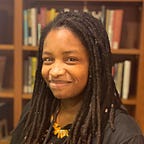A Story From The Edge: Using Qualitative Research To Report On Science Skeptics
Bias is limiting. Perspective is engaging.
Journalism has a myraid of definitions, I’ve learned. This is one way I, as a social journalist, am defining the craft:
The practice of observing and measuring the experience of another person, and shaping that perspective in a way that is both truthful to their story and engaging to the audience.
An important branch in anthropology, the study of human societies and cultures and their development, is ethnography. This is the scientific approach to gathering observations, interviews and documentary data to produce detailed and comprehensive accounts of different social phenomena. Dr. Lisbeth Berbary, a qualitative researcher and ethnographer at the University of Waterloo in Canada, video-conferenced with the Community Engagement class on Monday, October 15th.
She shared the various ways in which people and stories are studied, and how traditional approaches to research, analyze and interpret human stories are evolving as more voices and methods are being explored.
In a previous life, I was s a marine and environmental scientist. I was taught to be objective in my methodology, in my collection and analysis of data, and in my conclusion. When I took my biological statistics course later in my collegiate career, I learned about various ways to quantitatively analyze and interpret my data.
While it was interesting to learn, it was boring to do. It was a very structured, straight-lined way of explaining why my results were or were not significant.
In the evolving fields of journalism and ethnography, the interpretation of the conclusion depends on how the journalist or researcher prepared, how the data was collected, who was interviewed and what they were being asked.
As a scientist-turned social journalist, I’m learning to move past the quantitative breakdown of facts to an understanding that there is more than one way to imagine a person or community’s story that can be both accurate and compelling.
For my particular community of science education, I would leverage constructionist research techniques. Proper preparation for interviews and stories within the community is critical to understanding the “why” people believe and share misinformation on climate science, for example, whether intentionally or otherwise.
The responsibility of explaining a multifaceted community to an audience falls on the journalist. “Read people who are writing theory that represent different perspectives,” shared Dr. Berbary during her video call. “It allows you to think more critically and more well-roundedly about other people’s experiences.”
“This approach requires the journalist to show the perspectives of all the complexities of an issue.”
Reading and researching the ideas that are popular within my climate science skeptic community is a requirement not a suggestion. As I dig deeper into my research, I starting to see a spectrum of skepticism in climate science.
“This approach requires the journalist to show the perspectives of all the complexities of an issue,” continued Dr. Berbary. “It’s not just the accepted beliefs.”
Failing to prepare in this manner could result in the propagation of another negative or misleading representation of the people I’m working to connect with, hurting my ability to build trust and relationships.
Interviewing individuals in the skeptic community I believe requires capturing information with singular, sequential questions, in addition to building rapport and maintaining neutrality. Gathering their opinions using a slow and comprehensive method can have positive impact on both the quality of the interview and the information collected.
The narative storytelling aspect of qualitative analysis for my community is best achieved through a counter-narrative inquiry. While the “meta-narratives often ignore or subsume the voices of non-dominant groups such as people of color, women, and lesbian, gay, bi-sexual, transgender or queer (LGBTQ) individuals,” with science skeptics potentially grouped in this category, I believe counter-narrative captures their positon more accurately.
“Counter-narratives offer alternatives, new ways of thinking, and new understandings of experience based on the lives of those individuals often silenced or left out of the dominant narrative,” as explained in Dr. Berbary’s report, ‘A Very Basic Review Packet for Humanist: Qualitative Research.’
Illuminating these ‘fringe’ or skeptical beliefs could be perceived as doing more damage than, good. However, as I’ve learned from Dr. Berbary’s work, there is value in researching, understanding and telling of perspectives from the non-dominant groups, as there are many different facets that make up how we know what we know (epistemology).
While I don’t intend to make the errors danah boyd highlighted during her Online News Association presentation in September of this year, I am determined to properly observe, research and interview these communities on the edge of fact and belief.
By taking the time to engage with the skeptic science community, and providing an opportunity to expand their perspectives and those of the audience I aim to reach, I believe I am taking a critical step forward in understanding how our society is evolving in the Digital Information Age.
